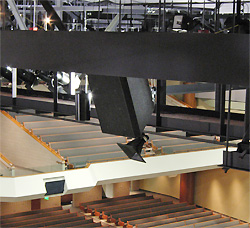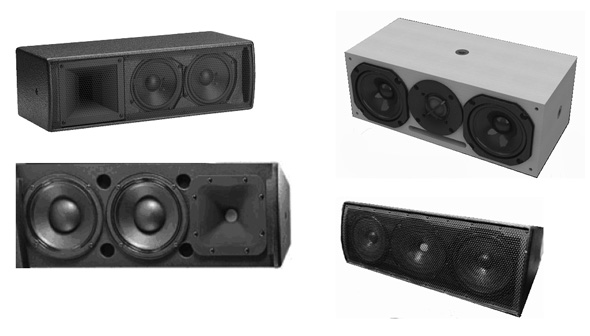
Fill Versus Boundary
When mounting underbalcony fill loudspeakers we often place them up against the balcony ceiling and angle them downwards to cover the target sets.
In doing so we create a cavity with a closed back. The diffracted energy from the loudspeaker, which wraps back into this cavity, is projected back out where it combines with the directly radiated energy.
At the same time, the slightly off-axis energy projecting from the loudspeaker reflects off the ceiling and combines with the directly radiated energy. The arrival time differentials at the listeners’ ears from these two unintended side-effects can create a notch in the frequency response (from the cavity) and smeared MF and HF response (from the reflections). Both of these are audible and measurable.
In any area where we apply fill loudspeakers we must be alert to the surrounding architectural conditions to ensure that the potential for such unexpected side effects are at least considered, even if it turns out we cannot completely address them.
Measurement & Optimization
In almost all cases, fill loudspeakers have very little impact on the performance of the primary and other fill loudspeakers. This is due to several factors including the limited area they cover, the low acoustic output required from them, the distances between one system and the other, and the isolation frequently provided by architecture.
Most fill systems simply do not “register” when one is listening to (or measuring) the primary clusters. Specifically, while measuring the primary loudspeakers when the fill loudspeakers are turned on and off, there is almost always no aural (perceived) or measured change from within the seating covered by the primary speakers.
Obviously, the primary loudspeakers do impact the seats covered by the fill loudspeakers, and this occurs mostly at middle and lower frequencies.
When measuring and optimizing fill systems, we focus almost entirely on alignment, level and equalization relative to the primary loudspeakers. If we’re lucky (and/or have the clout), we can select the most appropriate fill loudspeakers, locate them exactly where needed, conceal them (or reduce their visibility), and painstakingly apply measurement and optimization.

When all of these ducks are in a row the result is that every seat has great sound and the fill loudspeakers work so well that they may even appear to not be on. When muted there is a very clear difference.
Most folks know all too well that touring and one-off show productions barely allow enough time for thorough measurement and optimization of the primary loudspeakers and stage monitor systems. So setting up and optimizing fill loudspeakers is rarely possible.
Competition with the other trades/disciplines, along with the very limited time available for everything to be set up, dictates that we simply do the best that we can.
Although this often may be good enough for the audiences at such shows, we must be aware that completely ignoring the destructive interactions that occur and doing nothing about them yields compromised sound quality.
In particular, sources with percussive elements can get lost at times or (in some cases) are simply not audible at all. And intelligibility takes a big hit.
Exceptions to the above “rule” are the bus and truck tours of Broadway shows as well as corporate events where the loudspeaker systems are more carefully designed.
Further, the sound crew is allowed more time to optimize the performance of the loudspeakers, including localization.
A complete discussion of alignment philosophies cannot be thoroughly covered within the confines of this article. Many sound system technicians, designers and contractors employ additional delay for the purpose of moving the fill loudspeaker energy behind the primary source energy.
The Haas and Precedence effects are the theoretical justification for this but (in this case) are incorrectly applied. Such misalignment degrades coherence and therefore intelligibility, and is also simply unnecessary for maintaining localization.
Tom Young is the principal consultant at Electroacoustic Design Services with both worship and performance space projects in and around New York City and throughout New England. EDS specializes in sound reinforcement system design, loudspeaker system measurement and optimization, acoustic design and noise reduction.
